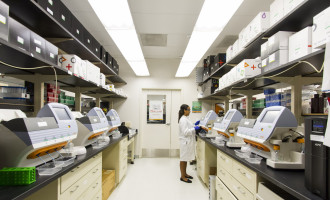
A three-dimensional (3D) bioprinting technology capable of eliminating cancer cells using the function of immune cells has been developed for the first time in the world.
Through joint research with the Korea Institute of Machinery and Materials (President Sang Jin Park, hereinafter referred to as KIMM), the Korea Research Institute of Bioscience and Biotechnology (President Jang Seong Kim, hereinafter referred to as KRIBB), an institute under the jurisdiction of the Ministry of Science and ICT, developed a 3D bioprinting technology using natural killer cells (NK cells)* as a new method of immunotherapy for treating cancer, and announced the outcome of the research on Biomaterials Research (IF: 11. 3)**, a renowned journal.
*NK cell: Natural killer (NK) cell is a leukocyte that responds to the formation of viruses and tumour cells, and selectively kills cells that are harmful to the human body. NK cells remove distressed cells that have been infected internally, rather than viruses that have intruded from the outside.
**Title: NK cells encapsulated in micro/macropore-forming hydrogels via 3D bioprinting for tumour immunotherapy (date of publication: June 22, 2023)
Allowing the 3D-printed hydrogels to encapsulate NK cells helps to prevent the loss of NK cells and enables a majority of those cells to home in on the tumour cells. Pores form in the hydrogel, and NK cells that retain cell viability are released after a certain amount of time, which allows for the performance of immune functions.
Although NK cells are generally used for immunotherapy, the method of injecting NK cells via intravenous injection has not shown effective results in clinical trials on solid tumours*. This is because NK cells are incapable of retaining an appropriate level of viability and fail to target solid tumours.
*Solid tumours: Solid tumours refer to malignant tumours that are composed of vascular and connective tissues and have solidity and form.
On the other hand, by using the newly developed technology, NK cells can be injected into the hydrogel, printed, and then cultured in a 3D environment, which enhances the cell viability and activity of NK cells and enables those cells to confront cancer tissues.
Principal Researcher Su A Park of KIMM was quoted as saying, “This technology can help to significantly improve the functionality of NK cells that are used for cancer treatment. We expect to contribute to the treatment of cancer patients through this newly developed technology.”
This research was carried out with the support of the project for the “Development of multiscale-vasculature-laden skin composite tissue for evaluation of implantable nano-bio-sensors” sponsored by the Ministry of Science and ICT and the National Research Foundation of Korea, and the project for the “development of UnTACT systems for critical illnesses” conducted by the Convergence Research Center of the National Research Council of Science and Technology.
We are an independent charity and are not backed by a large company or society. We raise every penny ourselves to improve the standards of cancer care through education. You can help us continue our work to address inequalities in cancer care by making a donation.
Any donation, however small, contributes directly towards the costs of creating and sharing free oncology education.
Together we can get better outcomes for patients by tackling global inequalities in access to the results of cancer research.
Thank you for your support.